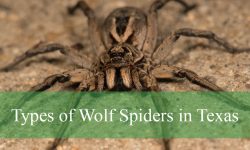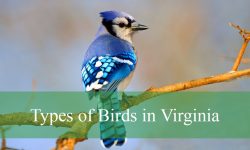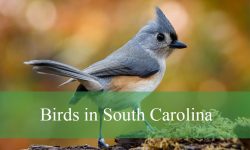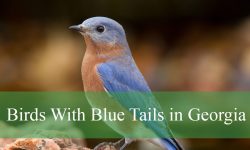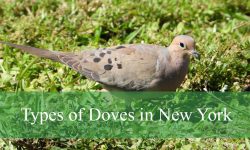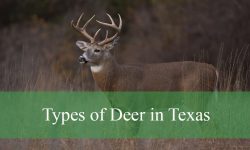Most types of black and brown caterpillars have strange-looking. But these worm-like creatures turn into beautiful moths and butterflies after pupation. Hairy black and brown caterpillars can cause skin irritation and nasty rashes.
Some other types have smooth bodies that make them harmless to humans. Identifying the exact name of a caterpillar spotted in your garden can be challenging. This identification guide provides pictures and descriptions of these crawling insects.
Are Black and Brown Caterpillars Poisonous?
Black and brown caterpillars are poisonous to humans, birds, and small rodents. But the toxicity varies from one species to another.
Hairy black and brown caterpillars have stinging hairs that cause skin irritation and nasty rashes. Refrain from handling any caterpillar without wearing protective gear.
Some black and brown caterpillars feed on plants that contain toxic substances. The ingested toxin is stored in the venom glands to control their circulation in their bodies.
The spines are usually connected to these toxic glands to transmit venom when they break into the skin. The toxin substances are responsible for nasty rashes and pain.
Other smooth-bodied black and brown caterpillars are harmless to humans. But they can be destructive to your crops and ornamental plants in your garden. (Source: Alabama Cooperative Extension).
Different Types of Black and Brown Caterpillars
We identify black and brown caterpillars with their size, shape, and markings. Here is a list of 14 different types of black and brown caterpillars with their pictures and descriptions:
Ruby Tiger Caterpillar
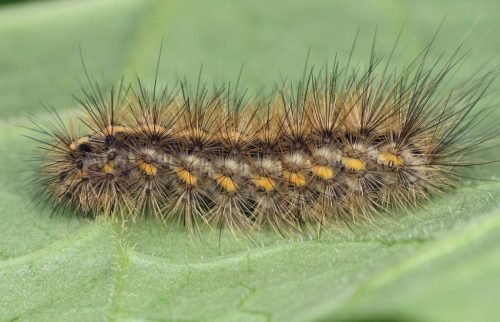
It is a moth caterpillar with dark brown and black hairy body. The red foxy hairs on the ruby tiger moth caterpillars are the identification features.
The tiny fuzzy caterpillar can grow up to 20mm long before pupation. The spines on the caterpillar come in different colors.
Some species have a black and hairy appearance with pale brown stripes. Others have rusty brown looks with black patches.
After pupation, the grub turns into a beautiful bright orange and reddish brown moth from July through September. Refrain from handling the caterpillars to avoid skin irritation.
Scientific Name |
Phragmatobia fuliginosa |
Host Plants |
Ironweed, plantain, cabbages, kale, and sunflowers. |
Identification Feature |
Tiny dark brown and black hairy caterpillar |
Eastern Tent Caterpillar
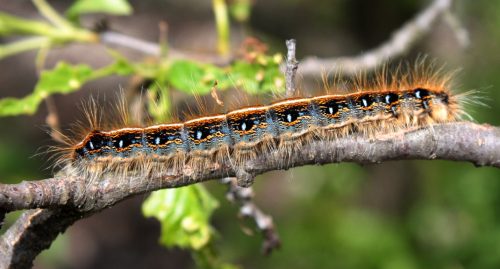
It is a slender brownish-black insect with prominent brown and white bands along the back. Yellow setae, bulbous blackheads, and bluish-black spots are the other features.
The eastern tent caterpillar can grow up to 50mm long and loves living in large colonies on the trees. They feed on the foliage of the deciduous trees in early and mid-spring.
Tent caterpillars are poisonous crawling insects for horses. The venom can make a pregnant horse abort the fetus upon eating the leaves with hidden tent caterpillars.
Scientific Name |
Malacosoma americanum |
Host Plants |
Black cherry, crabapple, and apple |
Identification Feature |
Brownish-black appearance with tufts of yellow setae and white stripes running from the head to tail. |
Brown Tail Moth Caterpillar
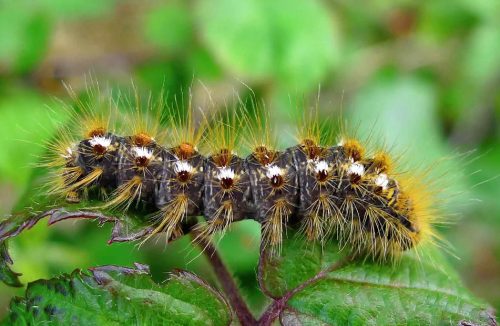
The crawling insect has a dark-brown to black hairy appearance with white patches along the sides. The tail end has two distinctive orange spots for easy identification.
The bright orange patterns on the head and tufts of spines on each segment are other identification features. The crawling creature can grow up to 25mm long.
These caterpillars love feeding on the leaves of oaks, maples, pears, and apples. These invasive caterpillars are not native to North America.
Scientific Name |
Euproctis chrysorrhoea |
Host Plants |
Oaks, apples, pears, and maples |
Identification Feature |
Brownish black hairy caterpillar with tufts of yellow setae along its sides. |
Black Witch Moth Caterpillar
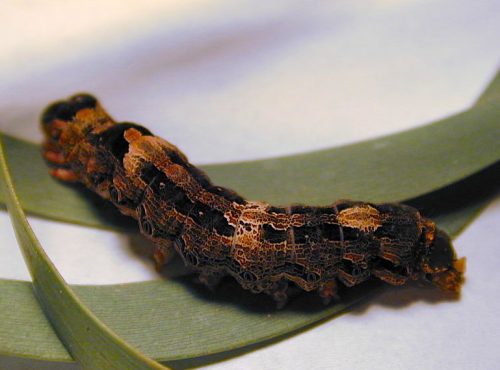
It is a giant black and brown caterpillar with black stripes, mottled patterns, and brown spots. The cigar-like insect feeds on legumes and is prevalent in the southern United States.
They can grow up to 70mm long in their final growth stage before pupation. These caterpillars are common in Florida and Texas after the start of the rainy season.
Scientific Name |
Ascalapha odorata |
Host Plants |
Legumes |
Identification Feature |
Large black and brown caterpillar with mottled markings, black stripes and brown spots. |
Common Buckeye Caterpillar

It is a spiky black butterfly caterpillar with brown stripes along its back. Other distinctive features are reddish-orange heads with black markings and orangey-brown spots.
The brown underside makes this crawling insect stands out from other species. This spiny black caterpillar with a cylinder shape can grow up to 40mm long.
Common buckeye caterpillars come in different variations depending on the location and climate. Some have branched spines and tiny white spots for easy recognition.
Other species have black bodies with white stripes. These crawling creatures turn into a beautiful painted lady butterflies after pupation.
Common buckeye caterpillars are among the popular bugs in Arizona and other desert states in the US. Be sure not to handle these grubs without wearing protective gear.
Scientific Name |
Junonia coenia |
Host Plants |
Plantain, monkey flowers, and snapdragon plants. |
Identification Feature |
Black caterpillar with branched spines, brown spots, and orange-brown spots on its abdomen. |
Salt Marsh Moth Caterpillar
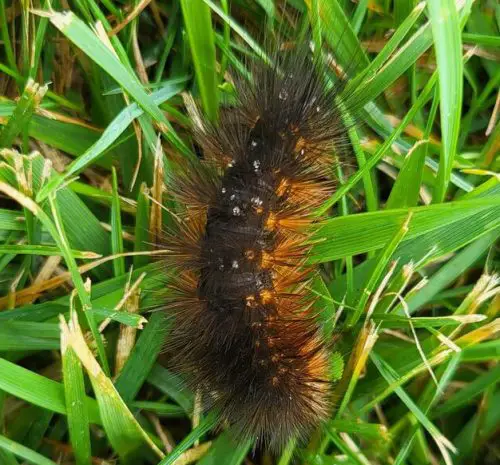
It is a rusty brown and black caterpillar with tufts of dark orange or black spines. The furry caterpillar has a tube-like body and can grow up to 50mm long.
The warty orange growths and white dots are other distinctive features for identifying salt marsh moth caterpillars. Besides that, they come in different color variations.
These fuzzy black and brown caterpillars have different body color ranges. Some have a dark brownish-black appearance and others rusty orange or pale yellow.
Scientific Name |
Estigmene acrea |
Host Plants |
Apple trees, clovers, cabbages, cotton, potatoes, peas, and tobacco. |
Identification Feature |
Slender and hairy body with orange spots rows and tufts of urticating spines. |
Imperial Moth Caterpillar
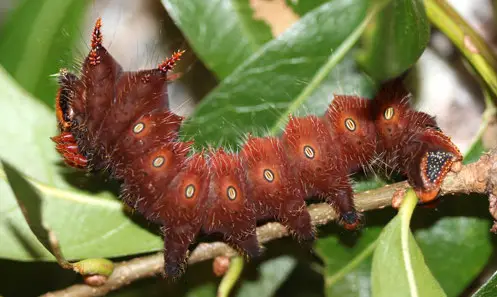
It is a large dark brown and black caterpillar with conspicuous red fleshy horns, pale wispy spines, and orange and yellow dots.
These scary caterpillars have three red horns on their head and a red tail horn for warding off potential predators. They can grow up to 100mm long in early and mid-spring.
The imperial moth caterpillars pass through different growth stages. The orange and black colors with long spines are prominent among juvenile species.
Mature caterpillars are longer with short spines. They turn dark brown, green, or burgundy depending on the location and climate.
Scientific Name |
Eacles imperialis |
Host Plants |
Pines, maples, oaks, and sweetgum species. |
Identification Feature |
A row of yellow-orange oval circles, fine hairs, and fleshy red spines. |
Pink-Spotted Hawkmoth Caterpillar
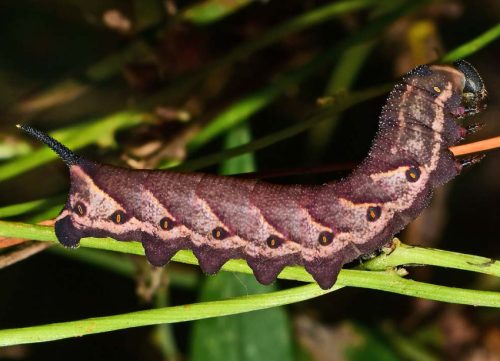
It is a beautiful dark brown caterpillar that looks almost black. The horned caterpillar has orange stripes and triangular patterns with eyespots on the smooth abdomen.
These large brown or black crawling insects can grow up to 80mm long. They are common garden pests in Texas where they feed on the leaves of sweet potato plants.
Scientific Name |
Agrius cingulata |
Host Plants |
Sweet potato plants |
Identification Feature |
Smooth dark brown body with creamy markings and orange stripes on the back |
Fox Moth Caterpillar
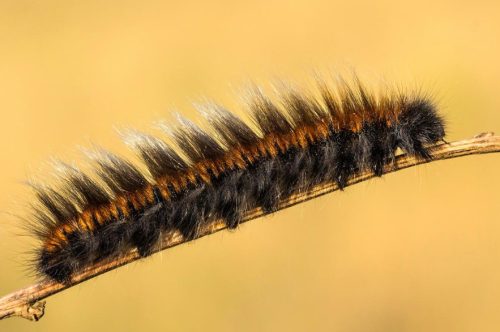
It is a slender long caterpillar with black and rusty brown bands. The furry caterpillar is also covered with fine black setae with tufts of grayish-white hairs along the sides.
The furry crawling insect has a rounded head, eight prolegs, and six front legs. The species in the initial instars have a black and bright yellow appearance.
These worm-like creatures become darker before switching to dark brown and black with tawny hairs in their final growth stage. They grow up to 80mm long.
Scientific Name |
Macrothylacia rubi |
Host Plants |
Heathers, bramble, sallows, salad burnet, and meadowsweet. |
Identification Feature |
Furry black and brown body covered in tufts of fine black or yellow spines. |
Scarce Dagger Moth Caterpillar
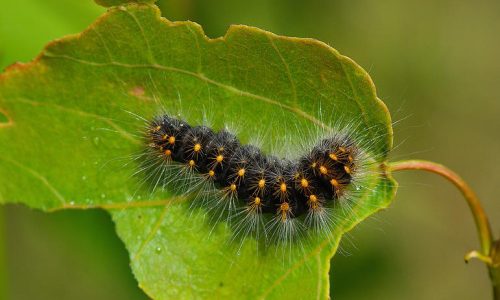
It is a type of black hairy caterpillar covered in tufts of orangey-brown hairs coming from yellowish bumps. The grub also has an orange head with a dense covering of fine setae.
These crawling insects may appear spiky black in their final growth stages. These black and brown caterpillars are often seen from May until August.
After pupation, scarce dagger caterpillars turn into white and gray moths. These fuzzy black and brown caterpillars also have irritating hairs upon touching them.
Scientific Name |
Acronicta auricoma |
Host Plants |
Oak and bilberry |
Identification Feature |
Slender worm-like body with black body and tufts of pale brown or orange spines |
Elephant Hawk Moth Caterpillar
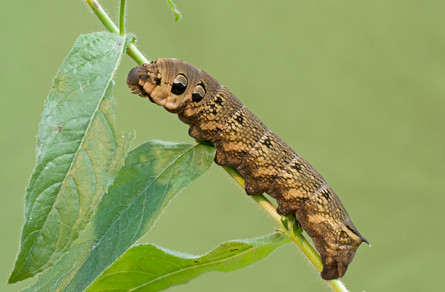
It is a type of horned caterpillar with a plump body and eye-like dots on its head. Juvenile larvas have slender bodies with bright green or yellow-white colors.
Mature elephant hawk moth caterpillars have brown-dark gray bodies with black dots along their abdomen. These horned caterpillars can grow up to 75mm long.
These fat caterpillars turn into beautiful brown and pink furry moths with pale pink legs and antennae. They feed on willow herbs, bedstraws, grapevine, and primrose.
Scientific Name |
Deilephila elpenor |
Host Plants |
Willow herbs, bedstraws, grapevines, and primrose. |
Identification Feature |
Brown body with black markings and eye-like spots on the head. |
Garden Tiger Moth Caterpillar
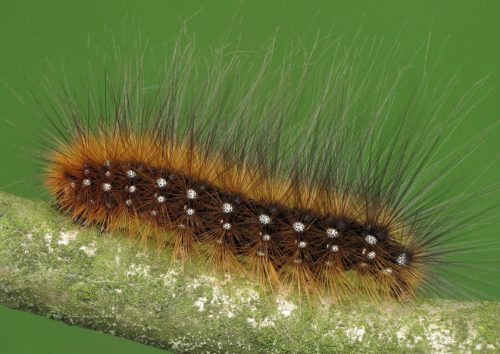
It is a moth caterpillar covered in long hairs and spines with black and brown colors. The garden tiger moth caterpillar belongs to the woolly bear family.
The black furry body with a reddish brown band along its sides is the distinctive feature for easy recognition. The spines have venom and can cause skin irritation or rashes.
Garden tiger moth caterpillars are often seen in the late summer when feeding on crops and other plants. They thrive in the warm Florida climate in the month of September.
These caterpillars turn into beautiful brown and fuzzy orange moths with bright wing patterns. Refrain from handling these caterpillars without wearing protective gear.
Scientific Name |
Arctia caja |
Host Plants |
Cherries, blackberries, clovers, and plantains |
Identification Feature |
Black hairy body with orange-brown colors along the sides. |
Drinker Moth Caterpillar
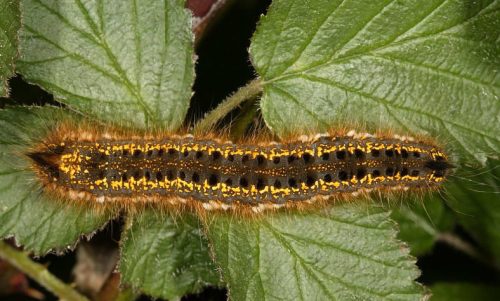
It is a black and brown caterpillar with orangey tufts of hair and two of rows yellow or orange dots on its back. The white markings along its sides are also conspicuous.
These caterpillars may look black and orange depending on the climate. They can grow up to 61mm long before pupation.
Drinker moth caterpillars feed on grasses and reeds in marshy areas. The larva turns into a stunning furry yellow or rusty brown moth.
Scientific Name |
Euthrix potatoria |
Host Plants |
Grasses and reeds |
Identification Feature |
Black body with fuzzy prolegs and tufts of orangey setae. It also has small brown tufts and orange or yellow speckles on its back |
Woolly Bear Caterpillar
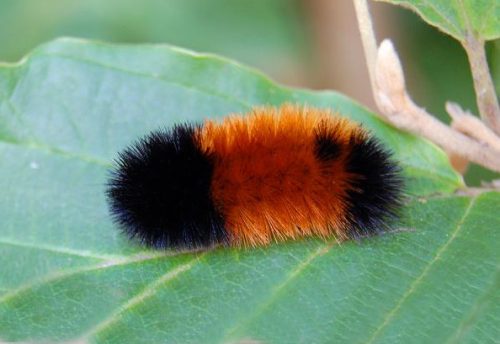
A woolly bear larva is a brown and black fuzzy caterpillar with a jagged appearance to scare potential predators. These harmless furry caterpillars are safe to handle.
These caterpillars are also called the black-ended bear since the black color is more prominent than brown. It becomes woollier and reddish before pupation.
Woolly bear caterpillars can grow up to 60mm long and turn into attractive orange moths with black spots along the abdomen after pupation.
These caterpillars feed on milkweed, dandelion, nettles, and other low-growing plants in the garden. You can also spot them on violets, asters, elm trees, and birches.
Scientific Name |
Pyrrharctia Isabella |
Host Plants |
Birches, elms, asters, and violets |
Identification Feature |
Furry appearance with a brown band between black ends. |
Related Articles:

